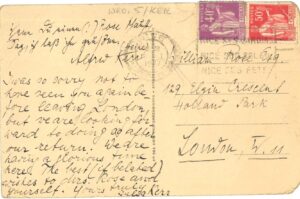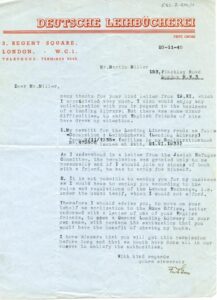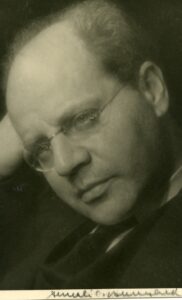The Refugee Week theme this year is ‘We Cannot Walk Alone’, and the IMLR is marking it with a guided walk around Bloomsbury following the trail of the 1930s refugees from Nazi Europe. The walk brings to life work by the Research Centre for German & Austrian Exile Studies and uses voices and images from the IMLR’s exile archives to illustrate the stories uncovered by this research. This is the first of two blog posts by Miller Archivist Clare George on the Bloomsbury buildings and institutions that played a role in the history of this community.

Postcard from Julia and Alfred Kerr to German Studies scholar and refugee supporter William Rose, 1937 (WRO/5/KER)
The ‘On the Trail of Refugees’ tour traces the many sites which drew the 1930s refugees from Nazi Europe to Bloomsbury. The district’s cheap accommodation, relative to its central location, was one of the main attractions for the new arrivals. The experience of refugee life in one of the district’s low-budget boarding houses was captured by writer Judith Kerr in her semi-autobiographical novel Bombs on Aunt Daisy. The tour takes in the site of the Kerr family’s home from 1935 until the Blitz, the former National Hotel in Bedford Way, immortalised in the novel as the Hotel Continental. Extracts from oral history audio recordings will allow participants to hear other refugees recalling their experiences of staying in Bloomsbury’s boarding houses in the early days of the Second World War.
For the many artists and writers amongst the refugees, Bloomsbury’s Bohemian reputation added to its appeal. The Austrian author Hans Flesch-Brunningen, who was taken by a friend to a boarding house in the district immediately after his arrival in the UK, was one of those who fell under Bloomsbury’s spell. His enchantment stemmed in part from his pleasure at sitting in the British Museum Library ‘under the vast dome of the great reading room … where the exile Karl Marx had sat in the 19th century’. The Library was of course a popular haunt of many other 1930s exiles, who often had little money but plenty of time on their hands since employment options were so limited. Regular refugee users of the Library included anthropologist Ernst Bornemann, political activist Margaret Mynatt, and Austrian author Stefan Zweig, in London from 1934 to 1939, who called it ‘die schoenste Bibliothek der Welt’.

Letter from Fritz Gross to Martin Miller concerning the Deutsche Leihbücherei (German Lending Library) at 3 Regent Square 1940 (EXS/2/GRO/4)

Fritz Gross, 1940 (EXS/2/GRO/3). Photographer: Anneliese Bunyard (by kind permission of Peter Bunyard)
A library of a very different scale, and the opportunity to discuss anti-Nazi activities, brought refugees to 3 Regent Square, in the north of the district. The basement of this house was rented by the political campaigner and pacifist Fritz Gross, who left Germany in 1933 bringing with him his large collection of German-language books. This he used as the basis of a lending library for refugees, gaining official approval from the British authorities to do so in 1935. The flat also served as a meeting point for exiled anti-fascists and other activists, and it was described by Nazi spies at the German Embassy as a central meeting spot for anti-German agitators in London.
Another meeting point for politically-minded refugees thinking ahead to the post-war states to which they would return was the Mary Ward Settlement, which hosted the discussion group ‘Das kommende Österreich’ during 1941. The group stressed the importance of cooperation between all exile groups, but in this case it was the British authorities who were unsettled, suspicious of the group because of its members’ connections with exile Communist groups.
Ten minutes’ walk from the Mary Ward Centre was one of several other Bloomsbury locations associated with the anti-Nazi activists. Socialists Dora Fabian and Mathilde Wurm had left Germany in 1933 to continue in exile with their work to expose the criminal nature of the German regime. They were found dead in the flat they shared in Great Ormond Street in April 1935. The involvement of Nazi agents was suspected by many refugees, and the affair led to extensive discussion in the press and House of Commons about Nazi and anti-Nazi activities in the UK. (The story of Dora Fabian and Mathilde Wurm will be the focus of a talk by Charmian Brinson in October 2021 as part of the Bloomsbury Festival.)
To find out more about this and other sites of historical importance to the refugees, please join us for a free guided tour led by Clare George (Miller Archivist/Research Centre for German & Austrian Exile Studies at the IMLR). Advanced booking is required. Please follow one of the following links to book:
17 June 2021, 11.00am – 12.30pm BST
18 June 2021, 2.00pm – 3.30pm BST
19 June 2021, 11.00am – 12.30pm BST
Those who cannot make the guided walks could instead listen to our audio walk, created for the Being Human Festival in November 2020.
Dr Clare George, Miller Archivist/Research Centre for German & Austrian Exile Studies at the IMLR
